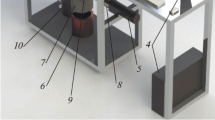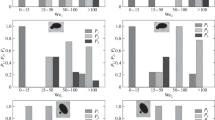Abstract
The dependence of the outcome of the collision of uncharged water drops with a plane water surface on the impact angle α, the velocity v1 and the radius r1 of the drops has been investigated experimentally. The impact parameters were varied over the intervals: v1=0.40–1.05 m/sec, r1=75–150μm, and α=16-85°. The method employed made it possible to avoid having to monitor the individual high-speed impact process. A stream of drops, produced in a “vibrating reed” type monodisperse droplet generator, was directed at the target. The impact parameters were measured by means of pulsed illumination. The results are expressed in the form of the dependence of the rebound probability and the coalescence coefficient ES on the impact parameters. The existence of alternating conditional rebound-coalescence-rebound zones for different impact angles is established, together with a decrease in ES with increase in r1 and v1. The data obtained generalize the results of previous experiments.
Similar content being viewed by others
Literature cited
S. V. Gorbachev and V. M. Nikiforova, “Upper limit of the stability of colliding water drops,” Zh. Geofiz.,5, 237 (1935).
A. V. Kolpakov and S. Zh. Kontush, “Mass transfer characteristics associated with the collision of water drops of noncomparable size,” Meteorol. Gidrodin., No. 12, 56 (1981).
P. S. Prokhorov, “Explanation of the mechanism of noncoalescence of colliding drop-lets,” in: New Concepts in Aerosol Science [in Russian], Izd. Akad. Nauk SSSR, Moscow (1949), p. 102.
D. M. Whelpdale and R. List, “The coalescence process in raindrop growth,” J. Geophys. Res.,76, 2836 (1971).
M. A. Aganin, “Laws of water drop coalescence,” Zh. Geofiz.,5, 409 (1935).
O. W. Jayarathe and B. J. Mason, “The coalescence and bouncing of water drops at an air interface,” Proc. R. Soc. Ser. A:280, 545 (1964).
R. M. Schotland, “Experimental results relating to the coalescence of water drops with water surfaces,” Discuss. Faraday Soc., No. 30, 72 (1960); Discuss. p. 139.
N. P. Tverskaya, “Determination of the water drop collision efficiency factor,” in: Proceedings of the Main Geophysical Observatory, No. 47 [in Russian], Gidrometeoizdat, Moscow (1954), p. 109.
W. R. Wolf, “Study of vibrating reed in the production of small droplets and solid particles of uniform size,” Rev. Sci. Instrum.,32, 1124 (1961).
A. V. Kolpakov, K. V. Romanov, and E. I. Titova, “Calculation of the rebound condition for colliding drops of sharply different sizes,” Kolloidn. Zh.,47, 953 (1985).
J. W. S. Rayleigh, The Theory of Sound, Vol. 2, Macmillan, London (1894).
Author information
Authors and Affiliations
Additional information
Translated from Izvestiya Akademii Nauk SSSR, Mekhanika Zhidkosti i Gaza, No. 3, pp. 165–168, May–June, 1990.
Rights and permissions
About this article
Cite this article
Zhbankova, S.L., Kolpakov, A.V. Collision of water drops with a plane water surface. Fluid Dyn 25, 470–473 (1990). https://doi.org/10.1007/BF01049832
Received:
Issue Date:
DOI: https://doi.org/10.1007/BF01049832




